PETER PEARSON 1823 - 1907
Peter was born in Witton Gilbert during 1823, the second child, and eldest son to a woodman named Peter Pearson and his partner Jane Nixon. Like his grandfather, Peter grew up to be a master joiner and carpenter, serving the village he lived in, by making cart wheels. Also, like his grandfather, Peter was most likely to have been, at some point, the local coffin-maker, such as his trade would have dictated. By 1851, he worked in a hardware shop in Witton Gilbert, but by 1861, Peter's main trade was listed as a joiner and Cartwright, still being registered in that profession by 1901 and 1907.
He wed Isabella Trotter, of Northumberland, in 1859, but the latter died in Witton Gilbert, believed to be in childbirth on 9th July 1865. Their only child, named Eliza Mary Pearson was baptised in Witton Gilbert on the 9th July 1865, and died exactly one week later. Both are buried in the same grave as Peter in the churchyard of
St. Michael and All Angel in the village. Peter is recorded on the 1861 census as living with his wife, and his brother, Joseph, as well as an apprentice living under their roof, named Benjamin Swalwell, a native of Bishop Auckland. Their home, in 1861 was situated adjacent Peter's father, most likely on Front Street in the village. Times only changed rapidly in Witton Gilbert, with the introduction of the collieries from 1839 onwards, and prior to that, the area was mainly agricultural. Most of the locals, prior to 1839, appear to have lived and died in the same premises;
In 1881 Peter was living at 65 High Street in Witton Gilbert, where he had a servant named Margaret Young,
a spinster who was born at High Moorsley in 1840, and the Witton Gilbert curate, Father Charles Henry Hardy Fleetwood from Ireland also shared this home. This was thought to have some connection to Peter's involvement with the church. Fleetwood was born around 1849 in Bridgham in Ireland, and only came to live in England between 1871 and 1881. It isn't known how long he stayed at Peter's premises, but by 1891, he was living in the parish of
St. Oswald in Durham with his wife, Alice Appleton who he had married the previous year in Tynemouth. In 1911, Charles and Alice lived at Gateshead.
When Peter Pearson died on 9th January 1907, he most likely lived at 33 Front Street in Witton Gilbert. According to the 1901 census, he still had the same housekeeper. Following his wife's death in 1865, Peter never remarried. He was buried in Witton Gilbert churchyard around the 12th January 1907, and a cross - shaped headstone marks his burial place. For 46 years, until his death, Peter was Rector's Churchwarden in Witton Gilbert. We know this from old records, as well as him having a keen interest in the church and the local school. In 1890, he was joint Churchwarden alongside Mr. James Wilson. The latter was the former village schoolmaster, who had resigned in 1894, later becoming the post-master. His two daughters’, Mary and Annie Wilson, helped deliver the mail in the village and to the local farms. Unlike peter, James Wilson was not a native of the village, both he and his wife' originated from Northumberland around the 1840 mark. They had moved to Witton Gilbert from Yorkshire between 1862 and 1865, and in 1881 lived at 9 High Street in the village. Nancy, his wife, assisted at the local school in the guise of Sewing Mistress.
In 1900, Peter sported a fine beard, once again, this strange fact been given on old records for Witton Gilbert. According to these records, he and his ‘brother’, John, made carts and wheels for Witton village in their workshop behind the Three Tuns public house, which, by all accounts was situated near to where the derelict garage now stands at the opposite side of the junction of Front Street and Sacriston Lane. When they had fixed the spokes to the rims, John and Peter would roll the wheels through an adjoining archway on to Front Street and down to
Mr. Bainbridge, the Blacksmith's shop next to Snookacres Farm to have the iron bands shrunk tightly on.
In Peter's later years, the layout of Witton Gilbert's east side seemed to consist of many shops along Front Street., with Snookacres Farm possibly being the oldest building in the village, built around the 1630s. The Blacksmith's shop was an adjoining part of the Farm and was used for shoeing horses in World War One, as well as making bicycles I think. From calculations, it is shown that Peter's Carpenter shop lay approximately a further 10 or 11 buildings to the north of the Blacksmith's shop, next to Best's Yard; which in turn lay adjacent to the Glendenning Arms public house.
Peter was quite a well liked, respected man in Witton Gilbert, by all accounts, and was probably the last of the Pearson line of his grandfather, Peter Pearson (1759 -1841) to have lived in the village. Peter had lived in Witton Gilbert all his life, very rarely leaving its surrounds. As an elderly man, he survived the 1898 epidemic in the village, in which the spread of germs, due to excessive heat, claimed the lives of seven children and three adults, all between 14lh September and 9th October that year. When he died in 1907, Peter's obituary appeared in the Durham Directory Obituaries Index, (The rector wrote)

Later inspection of the records for Witton Gilbert, suggest that some of these written accounts may be inaccurate to some degree. We find little further evidence to suggest that Peter's brother, John actually existed. However, Peter did have a nephew, John Brownless Pearson (1838 -1904), the son of his only sister Sarah. John was born and died in the village and did serve his time as a master carpenter. When he died, in1904, John's body was found on Front Street, by the landlord of the Three Tuns public house, Mr. William Hunter, suggesting that John lived very near to Peter's carpentry shop. Also, these written records for the village, state that Peter's father,
Peter Pearson (1788 -1876) moved to the village after he finished working as a publican in Durham, and went to live at Fell House. This is quite accurate, except Peter (1788) was actually born in Witton Gilbert. This story is backed up, not only by the Parish Records, but also from an 1828 Trade Directory for the village, as well as a Court House record from 22nd July 1828,
SARAH PEARSON 1818 -1891
Sarah Pearson was born in Witton Gilbert between April and October 1818, during the reign of King George the Third. She was the eldest child to a Husbandman, Peter Pearson, and a local spinster, Jane Nixon. The latter married in 1823 when Sarah was almost five years of age. In the second decade of the 19th Century, Witton Gilbert consisted of no more than about 400 individuals. The village was mainly agricultural and village life here was abrupt, with manners, speech, and customs being very course. The whole village was mainly situated around one long street which dated to medieval times, and quite a few building here had been erected in the centuries beforehand, some of these buildings surviving to date.
Sarah was baptised on 25th October 1818 in the parish church of St. Michael and All Angel, a 12th Century church standing in a wooded surround about quarter of a mile from the Front Street. As a child, she experienced very little schooling and was evidently illiterate.

Right – St. Michael and All Angels, where Sarah was baptised and buried
As a youngster, she most likely helped out on the local farms with her father as well as learning the usual tasks of sowing and cooking from her mother. Tradition in those days meant that not many tradesmen of the period were prepared to take on female apprentices, and it was generally believed that a woman's place was in the home. However, relief from these general chores came in the form of market day, when Sarah would sometimes walk around with her parents, viewing any bargains on sale. The market was held on a regular basis at the Fold, towards the eastern end of the street, and continued to do so until the early 20th Century.
In the early 1820s, it is thought that Sarah had moved out of the village for a short time. Her father, during this period tried a new direction of work, taking up the post of Inn Keeper at the White Smocks Posting Inn, but when the Inn ceased to be of permanent use, the Pearson's returned to Witton Gilbert, residing at Fell House, opposite the entrance to Fulforth Farm, the latter being the dwelling of Sarah grandparent's, Joseph and Hannah Nixon. It is not known how long Sarah and her parents lived at Fell House but it is certain that they were not living there in 1844, as a family named Turner were the inhabitants then. At Fell House, Sarah's father worked as a Farmer and Waggoner
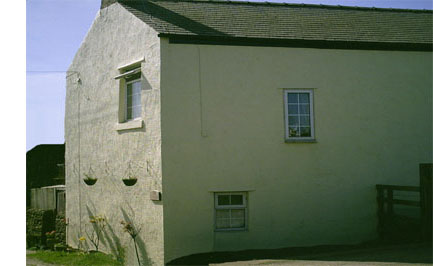
Right – Fell House
Where Sarah lived in 1828.
Sarah Pearson never married, but had three sons out of wedlock. The only connection that has been found, relating to the father or father's of these children, lies with the double-barrel surname of her eldest boy, John Brownless-Pearson, born at Witton Gilbert in 1838. Upon searching the parish records for the area, a certain John Smith-Brownless was discovered, he being born at Brancepeth around 1816. This man, in 1841, lived in the Lanchester district, dying there in 1887. He was a farmer, and in 1855, he married a certain Margaret Storey in Durham. Of course, this is only speculation whether he was the father of Sarah's son.
Being born out of wedlock in the 1830s, in a village like Witton Gilbert was frowned upon by the church, and for this reason, John Brownless-Pearson was partly raised by his grandparents. When Civil Registration for England and Wales became compulsory on 1st July 1837, it took a long time for people to grasp the new law. It is known that Sarah did not register her son, even though he was born the following year. There is, however, a John Pearson birth registered in Witton Gilbert in 1838, but he was the son of Sarah's cousin, Mary Pearson.
The church took a dim view towards illegitimacy, but religion was not as strong as it had been one hundred years earlier. Religion had come to Witton Gilbert in Norman times, but in the 1800s new churches were needed for the expanding population caused by the mining boom of 1839. Two Methodist chapels opened in Front Street in the 19th Century, but other religious orders were represented before that time. Following King Henry the Eighth's orders in the 16th Century, the Leper Hospital near the church, was closed as Henry continued his assault on anything or anyone none Church of England. In the 1620s, Witton Gilbert had a staunch Protestant curate named Canon Peter Smarte, who set about fiercely opposing Catholics in the neighbourhood.
Sarah's grandparent's, Peter and Mary Pearson, both died in the village during 1841 and never got the chance to see Sarah's other two children, Thomas and Edward Pearson, born in 1844 and 1846 respectively. Sadly, the former was only eight weeks old when he died, being buried in an unmarked grave in St. Michael's. This was followed in December 1857, by the death of Sarah's mother, Jane. Five years later came the sudden death of her brother, Joseph.
During the 1860s Sarah lived with her widowed father at 34 Front Street, this house being situated approximately half-way between the public houses called the Glendenning Arms and the Travellers Rest. At the rear of this house was the Carpenters shop belonging to Sarah's brother, Peter. Her son, John Brownless-Pearson was plagued by illness all his life and lived with his mother until her death in 1891. John helped out at his Uncle Peter's shop, eventually becoming a joiner and Cartwright in his own right.
Following her father's death in June 1876, Sarah continued to live at the same address. In 1883, records show that she suffered some form of injury to her thigh bone, an injury that stayed with her a further 8 years. She also suffered from a gastric ulcer and anorexia, all three contributing to her death on 13th October 1891. It is thought that Sarah was bed-ridden for a number of days prior to her death. Family were present at the time, including her son Edward, who at that time was living at Beechgrove at the foot of Edmondsley bank. Sarah was buried in an unmarked grave in the parish churchyard on 16th October 1891.
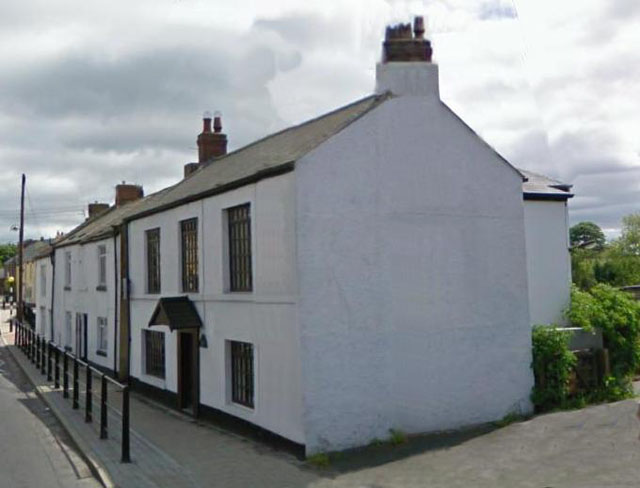
Right – Sarah Pearson is believed to
have died on these premises in 1891,
or in a building that occupied this site then
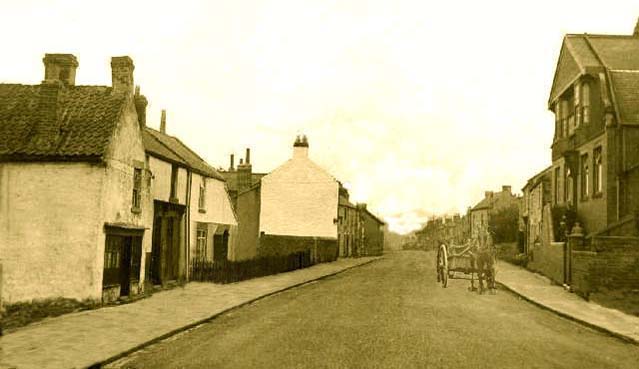
Right – A scene of WittonGilbert Front Street, and was most likely the image that Sarah viewed some years earlier
The offspring of Sarah Pearson 1818 - 1891
JOHN BROWN LESS PEARSON 1838 - 1904
John Brownless Pearson was the illegitimate eldest child of Sarah Pearson, being born at Witton Gilbert in 1838.
A recent visit to Bishop Auckland Registry Office proved unsuccessful in the search for John's birth certificate, leading to the suspicion that Sarah never registered his birth. All records from the registration districts of Chester-le-Street and Durham have been stored at Bishop Auckland since May 2006. A certain John Pearson was however recorded for 1837 for Witton Gilbert, but his mother's name was Mary Pearson, a cousin of Sarah. With reference to unregistered births since July 1837 - births could be registered within 6 weeks at no charge, thereafter it would cost 7 shillings and sixpence (in old money), a powerful incentive for informants to state that a birth had occurred later than it did. This explains why some people find they have 2 birthdays, a 'true' one and an 'official' one. John Brownless Pearson was baptised at St Michael and All Angel church, in Witton Gilbert, on Saturday 2nd October 1841.
He never married, and lived in Witton Gilbert village all his life, with his mother, until the latter's death in 1891. From around the 1840s until the 1890s, John and his mother had lived at High Street in the village, also referred to as Front Street, most likely in the same abode. Apparently, John himself was plagued with ill-health throughout his life. He earned his living as a carpenter, and in the 1860s, was described as a joiner and Cartwright, a trade he probably learned from his grandfather or his Uncle Peter. John is also recorded as a joiner and Cartwright in 1904. The Parish Records for the village insinuate that John worked with his Uncle Peter Pearson at their carpentry shop behind the Three Tuns Public House, around the turn of the Century.
In 1904, the story goes that on the day of John's death, the latter was seen walking passed Beech Grove, near Black - House, the home of his brother, Edward Pearson. John apparently waved to Edward and his wife, Ellen, the latter quoted as saying, “Look, there's our John”. John then walked the journey to Witton Gilbert He died on 11th December 1904, on the Front Street, in Witton Gilbert, his body being discovered by a local Licensed Victualler named William Hunter. John had suffered a heart attack. William Hunter was the publican of the Three Tuns public house. He died in Witton Gilbert on 26th August 1912. The quotation regarding the sighting of John, was relayed to me via his great-niece, who I can only assume had heard it from elder family members at some point.
John Brownless Pearson is buried in a marked grave in the village churchyard, also the resting place of
Peter Pearson (1823 -1907) and the latter's wife and daughter. The address that John lived at in 1904 appears to be number 34 Front Street. In 1861, John's grandfather lived next door to John's Uncle, Peter Pearson. The grandfather's home was also inhabited by John and his mother, Sarah. The 1861 Census only gives a schedule number for Front Street, but the 1901 Census gives an actual address. John was still living next door to his Uncle in 1901.
THOMAS PEARSON 1844 - 1844
Thomas Pearson was born in Witton Gilbert on September 4th 1844, the second illegitimate child of Sarah Pearson. He was baptised at St. Michael and All Angel church, in the village on 2nd October 1844. Apparently, my great-great grandfather Edward Pearson never seemed to mention Thomas much, leading to speculation that the latter may have died young. I had once mentioned to my great-aunt, that Edward Pearson had a brother named Thomas, but she disputed this. My research further enabled me to obtain Thomas' birth certificate, which inevitably proved my great-aunt wrong. Later research suggests that Thomas died on or around 31st October 1844 aged about 8 weeks old. He was buried, possibly at the foot of his great grandparent's grave in Witton Gilbert, on 3rd November 1844.
EDWARD PEARSON 1846 -1927
My great-great-grandfather was described as a very tall gentleman with a rose-red complexion that blended with a mass of white hair, and a personality second to none. He was very fond of children and fathered fourteen in total. Edward Pearson had a great love of the bible and for many years, taught sermons from the Methodist gospel, a book which he had purchased around 1862. In his later years he went almost blind and was cared for by his dedicated wife, Ellen. The latter was apparently a small lady with a large temper. She had an ailment at which the local doctor suggested she smoke a small clay pipe - from an old photograph it was shown that Ellen headed his advice.
Edward was born in Front Street, Witton Gilbert on Monday 7th September 1846, the third illegitimate child to a local spinster, Sarah Pearson. The village at that period in time was slowly becoming a densely populated area, mainly due to the opening of the local collieries about 7 years previous. Prior to the collieries, the area was mainly rural and agricultural. The village also thrived as a result of a market, held at the eastern end of the street, known as the Fold. Life in Witton Gilbert was abrupt, with manners, speech, and customs being course. This did not improve with the opening of the collieries, as the pitmen brought with them a new dialect - pitmatic. This was a language they seemed to use when talking to one another, and to the local tradesmen of the village, this must have sounded very alien and conflicting. On Thursday 3rd December 1846 Edward was baptised at the parish church of
St. Michael and All Angel. Nothing is known of his father, or indeed, if the latter was, or was not, the father of Edward's two brothers, John and Thomas Pearson.
Mrs. Elizabeth Gill was born in Gateshead, but during the 1850s was a local resident who worked on behalf of Witton Gilbert parish, and in 1851, she was made warden over Edward's well-being, in the form of parish relief. It is not clear why this occurred, as his mother was, at the time, still living in the village with Edward's elder brother John. It is believed that Elizabeth enrolled Edward into the National School which had been built in Witton Gilbert the previous year, and this is where he learned to read and write. The school was situated between the Coach Road leading to the church, and where the present rectory stands, and was very often overcrowded.
By the time he was fifteen, Edward Pearson had moved out of the village, and took up labour as a farm servant in North Hylton near Sunderland. Here, he worked at Town End Farm, but by 1862 had moved to Hett, near Croxdale. This is evident from Edward's bible which is dated from that year. Since the late 1750s, Edward's ancestors had been linked to the Hett area, living mainly in and around Butcher Race. The actual village of Hett was an old Anglo - Saxon village, its name meaning 'hat'. The village had been built on a large hill, and to the Saxon's, it resembled a hat shape. In the 1800s, agriculture was the main trade here and for the early part of the 1860s, it is thought Edward worked the farms in this area before turning his hand to coal mining around 1865. It was around this year that he moved to Butcher Race. For all the 1860s were moving with the Industrial revolution, Hett has never had a major colliery.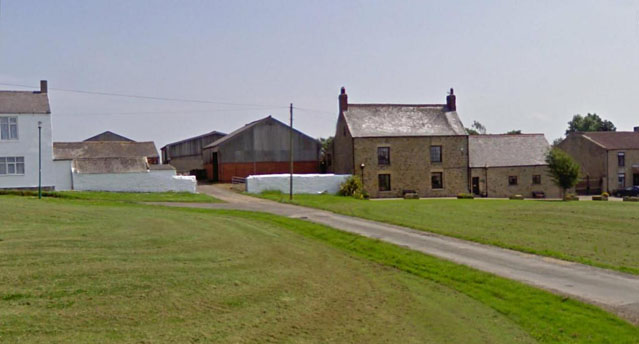
Right – Hett Village, where
Edward's future wife, Eleanor
and her family had lived in the
1860s, and when Edward
married Eleanor in 1866,
they had two stints here, from
1867 -1874, and from 1881 —1882
On 8 December 1866, Edward Pearson married Eleanor Jackson at St. Luke's Church in nearby Ferryhill and they set up home in Hett. The Jackson family had moved to Hett in the early 1860s from nearby Tudhoe. Eleanor's father, Leonard Jackson was a North Yorkshire coal miner who moved around with his work, finding employment in Bishop Auckland and then Hartlepool, before moving to Trimdon Colliery around 1848. Eleanor was born here a year later. Trimdon Colliery was also named Durham Five Houses. In 1851, the Jackson's were living at Quarrington Hill near Cassop and by the end of that decade were living in Tudhoe
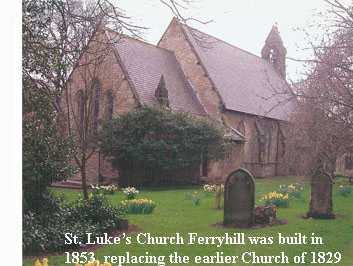 From the birth records of Edward's offspring, it is a straightforward quest in tracing his steps in the second half of the 19th Century. Following his marriage in 1866, he had remained in Hett until 1874. Upon their arrival back to Durham from Yorkshire, Edward and Ellen moved to Witton Station on the outskirts of Langley Park. The latter was just beginning to establish itself as a village and the most significant place near here was Witton Gilbert, and so, the station was named after the latter. The station had opened in 1862 and closed in 1966. The colliery at Langley Park was sunk in 1874 and Edward worked here until around 1880.
From the birth records of Edward's offspring, it is a straightforward quest in tracing his steps in the second half of the 19th Century. Following his marriage in 1866, he had remained in Hett until 1874. Upon their arrival back to Durham from Yorkshire, Edward and Ellen moved to Witton Station on the outskirts of Langley Park. The latter was just beginning to establish itself as a village and the most significant place near here was Witton Gilbert, and so, the station was named after the latter. The station had opened in 1862 and closed in 1966. The colliery at Langley Park was sunk in 1874 and Edward worked here until around 1880.
By the spring of 1881, Edward and his family had moved back to Hett for a short while, but within a year moved to West Hetton near Coxhoe.
The colliery here had opened in 1837 and originally, a collection of cottages named West Hetton Houses was built for the miners. Edward was still living in West Hetton in 1885 before moving closer to Coxhoe. However, the collieries were fast expanding and through his work, Edward once again moved home, this time residing in West Auckland.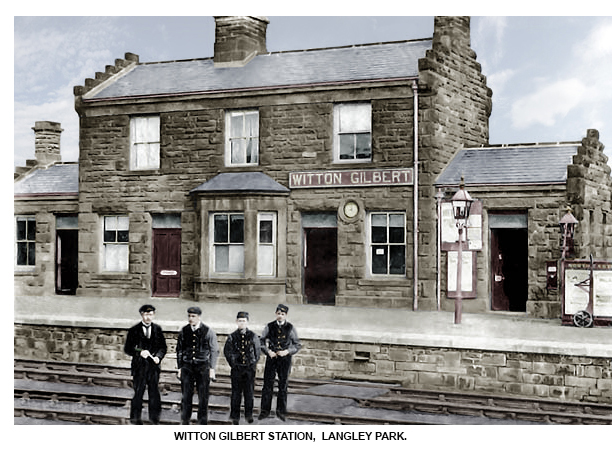
By the 1890s the Pearson's had moved to Craghead, and lived near the Middles at Bloemfontein. It was here that my great-grandmother, Ruth Pearson was born on 24th June 1890. Also from this part of Craghead, lived the noted Michael Heaviside, who later served as a private in the 15th Battalion Durham Light Infantry, and was awarded the Victoria Cross in World War One.
A large family requires a large house I suppose, and compared to the colliery houses in Craghead, and the smog filled air that covered the village, Beechgrove Cottage was an absolute blessing. As a child, growing up in Edmondsley, my grandmother visited this cottage regular. This was the Pearson's last abode leading up to the 20th Century. Edward had acquired this three room cottage adjacent Beechgrove Farm around 1891. The cottage, situated to the south of Blackhouse was about a mile from Craghead Colliery, and the air here was fresher than the colliery village. A well once stood at the foot of the garden. It was in Beechgrove Cottage that Edward's youngest child, Matthew Pearson was born in 1892, and today, a single gatepost and fragments of brickwork mark the spot where the cottage used to be situated.
By 1901, seven of Edward's fourteen children were still living at home, but eventually these offspring married and had families of their own, and by the turn of World War One, only Matthew lived with his parents. When the latter enlisted in the Machine Gun Corps he was eventually posted to Tincourt in France. Sadly, this was the last time Edward and Eleanor saw their son as he was killed in action one month before the War ended in 1918. He was buried in Tincourt New British Cemetery at the west end of the village.
In 1925, Blackhouse Village had been built on the opposite side of the main road from Beechgrove, and Edward and Eleanor moved here around that year. The village consisted of 164 houses, and the main street, Clayton Ville had been named after an early 20th Century Headmaster of Edmondsley School. Edward and his wife lived in number six Clayton Ville.
In his later years, Edward's eyesight deteriated to the extent where he would sit at the kitchen table, fumbling for his dinner plate. Time and again, he would accidentally knock objects from the table onto the floor, this being commonplace with his dinner fork. Without complaint, his dedicated wife would pick these objects up and place them back onto the table. This blindness was the cause of a misunderstanding between Edward and the local authorities. On one occasion he was taken from Beechgrove, to a workhouse in Chester-le-street. When his sons heard of this, they went in force and returned their father home to Beechgrove.
On 8th December 1927, Edward passed away at 6 Clayton Ville and the following year Eleanor moved to number 23 Clayton Ville. Here she died on 25th July 1929. Both she and her husband were buried in single, unmarked graves in St. Thomas' Churchyard at Craghead. Blackhouse Village was demolished around 1978 due to constant dampness problems, and today there stands an open field that was once a thriving community.
Below - left - Beechgrove Cottage once stood in this wooded area. Below - right - Blackhouse Village.

Below – St Thomas’ Church and Churchyard at Craghead.

The offspring of Edward Pearson and Eleanor Jackson
LENNARD PEARSON was the eldest child born to Edward and Ellen, being named after Ellen's father, Lennard Jackson (1818 - 1879). Lennard Pearson was born near Butcher Race in April 1867, four months after his parent's marriage. His baptism was held at St. Bartholomew's Church in Croxdale on 28th April 1867, but sadly, Lennard died not long after his birth.
THOMAS PEARSON was named after his father's brother who had died in 1844. The former was born near Butcher Race in 1868, and is thought to have died in the Gateshead area in 1898.
SARAH ANN PEARSON was named after her grandmother. The former was born at Hett in 1870 and lived with her parents until she married in 1891. On 17th January that year she wed Thomas Robinson in the district of Auckland, at the time, Sarah Ann was living at Bitchburn. Following their marriage, Sarah and Thomas went to live in Crook. It was here that their eldest child, Thomas William Robinson was born in 1893. By the mid 1890s, this family had moved to Consett. Sarah and Thomas' three other children were all born here between 1896 and 1906. Sarah lived in the Consett area for the remainder of her life, dying there around 1930. Her husband had died at Leadgate in 1928, being born at Crook on 4th February 1865.
JANE PEARSON was named after her grandmother on her mother's side, being born at Hett in 1872. Not much is known of Jane except that she probably lived in Consett for a while.
EDWARD PEARSON was named after his father, being born at Hett in 1874. In 1891, Edward was living with his sister, Sarah Ann and her husband, Thomas Robinson at Crook.
MARY PEARSON was the only child to Edward and Ellen not to have been born in County Durham. Mary was born in or around 1876 in Cowton, Yorkshire but this stay was brief before her parents returned to County Durham. Mary lived with her parents at Beechgrove near Edmondsley until she married in 1897. In that year she wed a Yorkshire man named John Harle, and following their marriage, they lived at Edmondsley, before moving to Jarrow in the first decade of the new century. Six offspring were found born to Mary and John, all born between 1898 and 1920